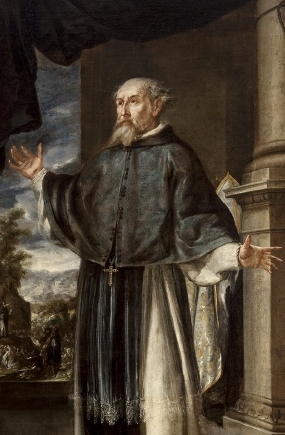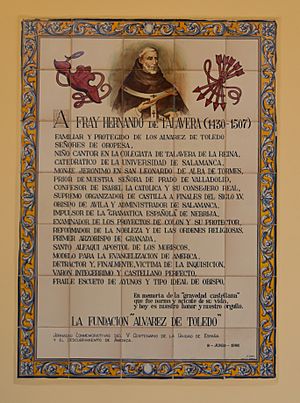Hernando de Talavera facts for kids
Quick facts for kids Servant of God Hernando de Talavera |
|
|---|---|
| Archbishop of Granada | |

Fray Hernando de Talavera (1656-57), by Juan de Valdés Leal, Museo de Bellas Artes de Sevilla
|
|
| Church | Catholic Church |
| Archdiocese | Archdiocese of Granada |
| In Office | 1492–1500 |
| Predecessor | Newly established |
| Successor | Francisco Jiménez de Cisneros |
| Personal details | |
| Born | 1428 Talavera de la Reina, Spain |
| Died | 14 May 1507 (age 79) Granada, Spain |
| Nationality | Spanish |
| Previous post | Bishop of Ávila (1485–1492) |
Hernando de Talavera (born around 1430, died May 14, 1507) was an important Spanish church leader. He was also a trusted advisor to Queen Isabel I of Castile. He started as a monk in the Hieronymite order. With the Queen's help, he became the Archbishop of Granada.
Contents
Early Life and Education
Hernando de Talavera was born around 1430 in Talavera de la Reina, Spain. His family background is not fully clear. He began his studies at the University of Salamanca when he was fifteen.
He earned his Bachelor of Arts degree three years later. He continued to study theology and law. Later, he taught moral philosophy at the university.
Becoming a Priest and Monk
In 1460, Talavera left the university. He became an ordained priest. Six years later, in 1466, he joined the Hieronymite order. This was at the San Leonardo de Alba de Tormes monastery.
In 1470, he became the leader (prior) of the Monastery of Nuestra Señora del Prado. This monastery was in Valladolid. There, he worked to make many important changes for his religious order.
Advisor to Queen Isabel
In the early 1470s, Queen Isabel I of Castile noticed Talavera's religious writings. She also saw his efforts to reform the church. A key supporter of the Queen, Cardinal Pedro González de Mendoza, may have introduced them.
By 1475, Talavera became Isabel's personal confessor. This meant he listened to her confessions and offered spiritual guidance. In January 1476, he gave her a special writing. It was called "How all loyal Christians should renew their spirits during Advent." This writing was more than just a sermon. It was a spiritual guide that greatly influenced the Queen's rule.
Talavera also served on the royal council. He was given important tasks for the Crown. In 1479, he went to Portugal. His mission was to ensure Isabel's rival, Juana of Castile, entered a convent. He also led a group looking into royal rights in the Canary Islands. Talavera also helped mentor a young Juan Rodríguez de Fonseca. Fonseca later became a powerful minister for Spain's growing colonial empire.
Columbus's Proposal
In 1485, Christopher Columbus asked the Spanish Crown for support. He wanted to sail west to find a new route to Asia. Talavera was likely one of the first people Columbus met at court.
Talavera helped Columbus meet Queen Isabel around 1486. The Queen then asked Talavera to create a group. This group would study if Columbus's plan was possible. The group met off and on. In 1490, they advised against the plan. However, in 1492, King Fernando and Queen Isabel decided to support Columbus anyway.
In 1486, Talavera was appointed the Bishop of Ávila. The city of Ávila had many Jewish and Muslim communities. His experience there helped him later when he became archbishop in Granada.
Archbishop of Granada
In 1492, Spain conquered Granada. The peace agreement guaranteed that the Muslim majority could continue practicing their religion. In 1493, Talavera became the Archbishop of Granada. This was a very difficult job, showing the Crown's trust in him.
However, his influence at court changed. Francisco Jiménez de Cisneros was chosen to replace him as Isabel's confessor.
Different Approaches to Conversion
Talavera believed in peaceful conversion. He wanted to explain Christianity to the people in their own language. He even learned Arabic himself. He encouraged his priests to do the same. The people of Granada respected Talavera. They were thankful he stuck to the peace agreement. However, his gentle approach resulted in few conversions.
Meanwhile, Cisneros's influence grew. When he became Archbishop of Toledo, he was the highest-ranking Catholic leader in Spain. In 1499, Cisneros came to Granada. He brought a much more forceful way of converting people. Talavera disagreed, but Cisneros went ahead. His actions caused a rebellion. Cisneros's life was in danger. Royal forces had to step in to stop the fighting. To prevent more bloodshed, Talavera offered forgiveness to rebels who converted to Christianity. About 50,000 people accepted his offer.
After the rebellion in the city, Cisneros continued his forceful efforts in the countryside. This led to a second rebellion. Again, royal forces were needed to stop it. Queen Isabel decided that a peaceful solution was not working. In February 1502, she issued an order. It required all adult Muslims in Castile to convert to Christianity or leave Spain.
Challenges and Later Life
Hernando de Talavera had been against the Spanish Inquisition for many years. After Queen Isabel died in 1504, Talavera faced accusations. Some claimed he held Jewish ceremonies in his palace. His relatives and household staff were arrested.
Talavera himself was not arrested until King Philip allowed it in July 1506. However, a church official, Giovanni Ruffo, appealed to Pope Julius II. The Pope cleared Talavera of all charges and ordered his release. Talavera died a short time later, on May 14, 1507.
See also
 In Spanish: Hernando de Talavera para niños
In Spanish: Hernando de Talavera para niños


